VOA慢速英语-EXPLORATIONS - Exploring the Nile in Egypt
时间:2019-01-07 作者:英语课 分类:VOA慢速英语2008年(七)月
Join us as we travel down the Nile to learn about this rich ancient culture. Transcript 1 of radio broadcast:
08 July 2008
VOICE ONE:
I’m Steve Ember.
VOICE TWO:
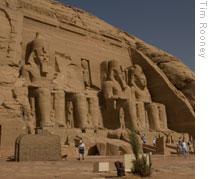
Abu Simbel
And I’m Faith Lapidus with EXPLORATIONS in VOA Special English. Today we visit the Nile River valley to explore one of the greatest civilizations in human history. The people of ancient Egypt developed the first nation-state, which would set the stage for a culture that would last thousands of years.
For centuries, the art, architecture, and traditions of ancient Egypt have captured the attention of historians 2, writers, and travelers around the world. Join us as we travel down the Nile and back through time.
(MUSIC)
VOICE THREE:
“We shall never enjoy another place like Ipsamboul; the absolute solitude 3 of it - the absence of a present, of any of one’s fellow-creatures … I came out of the [temple] and looked again upon the glorious colossi. I wish all my friends could see them once in their lives, if only for a moment; or that I could describe to anyone the look of intense repose 4 in those faces.”
VOICE ONE:
Those were the words written by British medical worker Florence Nightingale. She traveled to Egypt in eighteen forty-nine to explore its many sites. She is describing the temple of Abu Simbel in southern Egypt. Like many European visitors, Miss Nightingale wrote a detailed 5 description of her months of travel through this country.
VOICE TWO:
Our own trip down the Nile begins at the temple of Abu Simbel. The Egyptian ruler Ramses the Second built this extraordinary temple over three thousand two hundred years ago. The temple is dedicated 6 to the Egyptian gods Ra-Horakhty, Amun and Ptah. But it is really meant to show the power and strength of Ramses the Second who led Egypt for over sixty years. Like other pharaohs, Ramses was considered an earthly representation 7 of a god.
VOICE ONE:
Four twenty-meter tall statues of Ramses guard the front of the temple, which is carved into the side of a mountain. Staring up at these huge statues, you suddenly feel very small and impermanent compared to this timeless structure.
Inside the temple, detailed carvings 8 on the walls show Ramses defeating his enemies in battle. The walls also show examples of hieroglyphics 9, the form of Egyptian writing that uses pictures. This is the oldest known system of writing in the world.
VOICE TWO:
Like many Egyptian temples, Abu Simbel has a first room or hypostyle hall filled with column supports. Next, there is a second hall, followed by a sanctuary 10.
Only religious workers and the pharaoh were permitted to enter this last room. The sanctuary of Abu Simbel contains statues of the temple’s four gods.
VOICE ONE:
Next to this building is a smaller temple honoring the wife of Ramses the second, Nefertari. In the nineteen sixties, both temples were moved stone by stone from their original sites and rebuilt two hundred meters away. This was done as protection from the rising water of the Nile as a result of the building of the Aswan High Dam.
(MUSIC)
VOICE TWO:
Our trip continues in the town of Aswan where many travelers start their river trip on a boat that is like a hotel. There are many interesting places to visit in Aswan. They include the Nubian museum, the Aswan Botanical Gardens and the Old Cataract 11 Hotel. The British mystery writer Agatha Christie wrote part of her book “Death on The Nile” in this hotel.
VOICE ONE:
You can also visit the Aswan High Dam and the water it collects in Lake Nasser, the largest man-made lake in the world. The dam was built starting in nineteen sixty under Egyptian President Gamal Abdel Nasser. Its aim was to control the flow of water of the Nile. The dam has greatly increased the amount of farmland in Egypt and supplies the country with hydroelectric power. But the dam has also caused environmental and cultural problems. Our guide, Egypt expert Mohamed Fahmy tells us about the native people most affected 12 by the dam.
MOHAMED FAHMY: "The Nubians used to live here. There were one hundred thousand Nubians living in this place. But after the creation 13 of the lake they had to be displaced 14. Half of them decided 15 to stay in Aswan. They took the left bank of Aswan to be their new Nubia. The rest of them, they went to Sudan."
VOICE TWO:
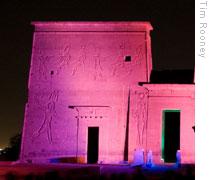
A building at Philae during the sound and light show
Another popular area near Aswan is the Greco-Roman temple of Philae. Philae is one of many monuments built after the Macedonian warrior 16 Alexander the Great took control of Egypt about two thousand three hundred years ago.
One of his generals, Ptolemy, took control of Egypt after Alexander’s death. He established a line of Ptolemaic leaders that ruled for three hundred years. To see Philae, visitors must take a boat to a small island.
(SOUND)
If you go at night, you can see a sound and light show. During the show, recorded voices of actors give a theatrical 17 history of the temple while it is lit up in bright colors.
ACTOR: "Oh Nile, father of life. All hail 18 to you. When your waters rise and your bounty 19 overwhelms 20 us.
The earth trembles with ecstasy 21, life is reborn, all is nurtured 22.
But when you subside 23, the very gods despair.
And men become slighter than their shadows."
VOICE ONE:
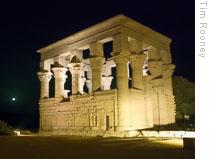
The Kiosk of Trajan at Philae
This temple was built in honor of the goddess Isis over two thousand years ago. One of the most famous buildings at Philae is the Kiosk of Trajan. It was a favorite subject in paintings by nineteenth century European travelers.
VOICE TWO:
Continuing down the Nile, we arrive at the temple of Kom Ombo. This Ptolemaic temple was built to honor two gods, the crocodile god Sobek and Haroeris. It is unusual because it has double gates and rooms in order to honor both gods. The wall carvings show the traditions and daily life of Egyptians. One wall has detailed carvings of medical tools. Our guide Mohamed Fahmy tells us about them.
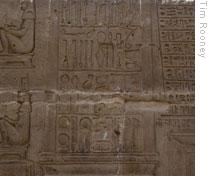
Carvings of medical tools at Kom Ombo
MOHAMED FAHMY: "Here they depicted 24 some of their medical instruments. Come closer to see it. Most of these, we are still using today. You can see a scissor, you can see a sponge 25, two stones to sharpen the cutters. And you can see a scale to weigh the materials. You can see two eyes in here. These are the eyes of Horus, symbol of protection."
Further north, there is also the Temple of Horus at Edfu. This Ptolemaic temple is one of the most completely preserved temples in Egypt.
(MUSIC)
VOICE ONE:
Now, we sail about one hundred kilometers north. This gives us time to enjoy the river scenes along the Nile. From the boat you can see palm trees, children playing in fields and local people rowing small boats. And you can wave to travelers on other hotel boats.
Our next stop is the ancient city of Thebes, known today as Luxor.
VOICE TWO:
Starting around three thousand five hundred years ago, a series of pharaohs built secret burial structures in the nearby Valley of the Kings. Pharaohs chose to be buried in this rocky area because it was far away from people and easy to protect. These burial structures were more secretive than the large pyramids of earlier pharaohs. Builders of these tombs dug tunnels that led to burial rooms for the ruler’s body and his treasures. These objects and the many paintings on the walls were designed to help the ruler in the next life.
VOICE ONE:
Few things were as important to Egyptian rulers as preparing for their death while they were still alive. This meant building complex burial structures that could help guarantee they would live forever in the afterlife. Egyptians developed a detailed method of preserving dead bodies, called mummification.
They believed that a body had to be carefully prepared and stored to survive in the afterlife.
VOICE TWO:
The most famous tomb in the valley belonged to the pharaoh Tutankhamun. He was not known for his activities as a ruler. Instead, he is famous for the treasures found in his tomb when it was discovered in the nineteen twenties. Most other tombs in the area were robbed over the centuries. But this one was in perfect condition and has taught experts a great deal about Egyptian funeral traditions.
VOICE ONE:
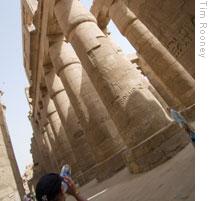
The Great Hypostyle Hall at Karnak
Also nearby is the village of Karnak. It was built to honor the gods of Thebes, a capital of Egypt in ancient times. For over fifteen hundred years different pharaohs built their own additions to the series of buildings at Karnak. The most striking 26 room of the Karnak Temple is the Great Hypostyle Hall, which covers six thousand square meters. It contains one hundred thirty-four huge stone columns. The columns were once brightly painted and held up a roof covering.
VOICE TWO:
The pharaoh Amenhotep built the central area of the nearby temple of Luxor about three thousand three hundred years ago. Other rulers also added to the building. At the entrance to the temple there is a long row of sphinx statues that once measured three kilometers long. These sphinx statues combine the body of a lion with the head of a human. Visiting this place at night is pure magic. As you walk along the rows of glowing sphinx statues, you feel like you have traveled back through time to a very ancient and extraordinary past.
(MUSIC)
VOICE ONE:
Next week we continue our travels in the modern Egyptian capital of Cairo. This program was written and produced by Dana Demange. I’m Steve Ember.
VOICE TWO:
And I’m Faith Lapidus. To see pictures of Egypt, visit our Web site, voaspecialenglish.com. Join us again next week for Explorations in VOA Special English.
- A transcript of the tapes was presented as evidence in court.一份录音带的文字本作为证据被呈交法庭。
- They wouldn't let me have a transcript of the interview.他们拒绝给我一份采访的文字整理稿。
- Historians seem to have confused the chronology of these events. 历史学家好像把这些事件发生的年代顺序搞混了。
- Historians have concurred with each other in this view. 历史学家在这个观点上已取得一致意见。
- People need a chance to reflect on spiritual matters in solitude. 人们需要独处的机会来反思精神上的事情。
- They searched for a place where they could live in solitude. 他们寻找一个可以过隐居生活的地方。
- Don't disturb her repose.不要打扰她休息。
- Her mouth seemed always to be smiling,even in repose.她的嘴角似乎总是挂着微笑,即使在睡眠时也是这样。
- He had made a detailed study of the terrain.他对地形作了缜密的研究。
- A detailed list of our publications is available on request.我们的出版物有一份详细的目录备索。
- He dedicated his life to the cause of education.他献身于教育事业。
- His whole energies are dedicated to improve the design.他的全部精力都放在改进这项设计上了。
- The painting is a representation of a storm at sea.这幅画描绘的是海上的暴风雨。
- All parties won representation in the national assembly.所有政党在国民大会中都赢得了代表资格。
- The desk was ornamented with many carvings. 这桌子装饰有很多雕刻物。 来自《简明英汉词典》
- Shell carvings are a specialty of the town. 贝雕是该城的特产。 来自《简明英汉词典》
- Hieroglyphics are carved into the walls of the temple. 寺庙的墙壁上刻着象形文字。
- His writing is so bad it just looks like hieroglyphics to me. 他写的糟透了,对我来说就像天书一样。
- There was a sanctuary of political refugees behind the hospital.医院后面有一个政治难民的避难所。
- Most countries refuse to give sanctuary to people who hijack aeroplanes.大多数国家拒绝对劫机者提供庇护。
- He is an elderly gentleman who had had a cataract operation.他是一位曾经动过白内障手术的老人。
- The way is blocked by the tall cataract.高悬的大瀑布挡住了去路。
- She showed an affected interest in our subject.她假装对我们的课题感到兴趣。
- His manners are affected.他的态度不自然。
- Language is the most important mental creation of man.语言是人类头脑最重要的产物。
- The creation of new playgrounds will benefit the local children.新游戏场的建立将有益于当地的儿童。
- Gradually factory workers have been displaced by machines. 工厂的工人已逐渐被机器取代。
- He was displaced by another young man. 他已被另一个年轻人顶替。
- This gave them a decided advantage over their opponents.这使他们比对手具有明显的优势。
- There is a decided difference between British and Chinese way of greeting.英国人和中国人打招呼的方式有很明显的区别。
- The young man is a bold warrior.这个年轻人是个很英勇的武士。
- A true warrior values glory and honor above life.一个真正的勇士珍视荣誉胜过生命。
- The final scene was dismayingly lacking in theatrical effect.最后一场缺乏戏剧效果,叫人失望。
- She always makes some theatrical gesture.她老在做些夸张的手势。
- Hail fell with such violence that it broke windows.冰雹猛落,把玻璃窗也砸破了。
- The people lined the streets to hail the returning heroes.人们夹道欢迎凯旋的英雄们。
- He is famous for his bounty to the poor.他因对穷人慷慨相助而出名。
- We received a bounty from the government.我们收到政府给予的一笔补助金。
- Your kindness quite overwhelms me. 你的好意使我感激难言。 来自《现代英汉综合大词典》
- Viscosity overwhelms the smallest eddies and converts their energy into heat. 粘性制服了最小的旋涡而将其能量转换为热。 来自辞典例句
- He listened to the music with ecstasy.他听音乐听得入了神。
- Speechless with ecstasy,the little boys gazed at the toys.小孩注视着那些玩具,高兴得说不出话来。
- She is looking fondly at the plants he had nurtured. 她深情地看着他培育的植物。
- Any latter-day Einstein would still be spotted and nurtured. 任何一个未来的爱因斯坦都会被发现并受到培养。
- The emotional reaction which results from a serious accident takes time to subside.严重事故所引起的情绪化的反应需要时间来平息。
- The controversies surrounding population growth are unlikely to subside soon.围绕着人口增长问题的争论看来不会很快平息。
- Other animals were depicted on the periphery of the group. 其他动物在群像的外围加以修饰。
- They depicted the thrilling situation to us in great detail. 他们向我们详细地描述了那激动人心的场面。
- The child is screwing water out of a sponge.小孩正把海绵中的水挤出来。
- You should try to sponge out the memory of the accident.你该努力抹除那次事故的记忆。